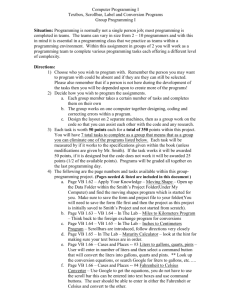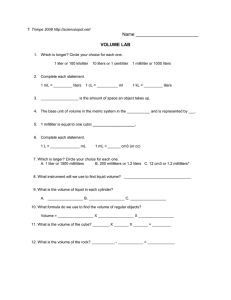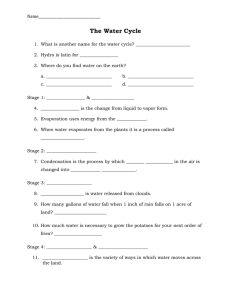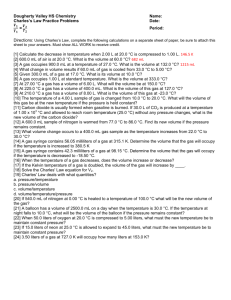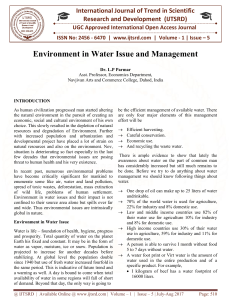UN Highlights World Water Crisis June 5, 2003
advertisement
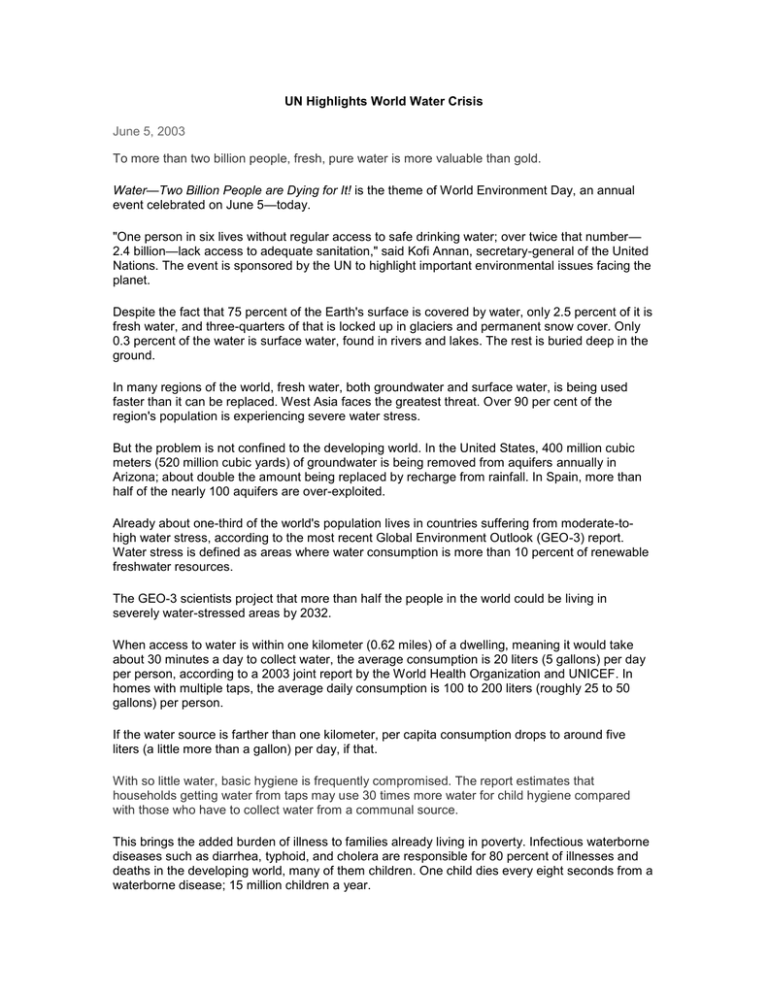
UN Highlights World Water Crisis June 5, 2003 To more than two billion people, fresh, pure water is more valuable than gold. Water—Two Billion People are Dying for It! is the theme of World Environment Day, an annual event celebrated on June 5—today. "One person in six lives without regular access to safe drinking water; over twice that number— 2.4 billion—lack access to adequate sanitation," said Kofi Annan, secretary-general of the United Nations. The event is sponsored by the UN to highlight important environmental issues facing the planet. Despite the fact that 75 percent of the Earth's surface is covered by water, only 2.5 percent of it is fresh water, and three-quarters of that is locked up in glaciers and permanent snow cover. Only 0.3 percent of the water is surface water, found in rivers and lakes. The rest is buried deep in the ground. In many regions of the world, fresh water, both groundwater and surface water, is being used faster than it can be replaced. West Asia faces the greatest threat. Over 90 per cent of the region's population is experiencing severe water stress. But the problem is not confined to the developing world. In the United States, 400 million cubic meters (520 million cubic yards) of groundwater is being removed from aquifers annually in Arizona; about double the amount being replaced by recharge from rainfall. In Spain, more than half of the nearly 100 aquifers are over-exploited. Already about one-third of the world's population lives in countries suffering from moderate-tohigh water stress, according to the most recent Global Environment Outlook (GEO-3) report. Water stress is defined as areas where water consumption is more than 10 percent of renewable freshwater resources. The GEO-3 scientists project that more than half the people in the world could be living in severely water-stressed areas by 2032. When access to water is within one kilometer (0.62 miles) of a dwelling, meaning it would take about 30 minutes a day to collect water, the average consumption is 20 liters (5 gallons) per day per person, according to a 2003 joint report by the World Health Organization and UNICEF. In homes with multiple taps, the average daily consumption is 100 to 200 liters (roughly 25 to 50 gallons) per person. If the water source is farther than one kilometer, per capita consumption drops to around five liters (a little more than a gallon) per day, if that. With so little water, basic hygiene is frequently compromised. The report estimates that households getting water from taps may use 30 times more water for child hygiene compared with those who have to collect water from a communal source. This brings the added burden of illness to families already living in poverty. Infectious waterborne diseases such as diarrhea, typhoid, and cholera are responsible for 80 percent of illnesses and deaths in the developing world, many of them children. One child dies every eight seconds from a waterborne disease; 15 million children a year. Women and female children who have to travel to collect water pay a high cost. Less time is available for caring for children, preparing food, or pursuing alternate economic activities. In some regions the women and girls must travel through unsafe areas and are vulnerable to attack. Families in many cases must forego sending their girls to school, perpetuating the grinding cycle of illiteracy and poverty. The amount of water a person needs can vary; a person doing manual labor in the tropics will need more water than someone sitting at a computer in a temperate zone. WHO suggests 2 to 4.5 liters (0.5 to 1 gallon) a day for drinking, and another 4 liters (1 gallon) for cooking and food preparation are the bottom-line limits for survival. This doesn't take into account water needs for growing food. The minimum quantity of water recommended by the U.S. Agency for International Development for household and urban use alone is close to 100 liters (26.4 gallons) per person per day. "This crisis is one of water governance, essentially caused by the ways in which we mismanage water," conclude the authors of the UN's World Water Development Report (WWDR) issued in March. Freshwater resources are being further squandered due to pollution and the way in which we use water. Some two million tons of waste per day are disposed of within receiving waters, including industrial wastes and chemicals, human waste and agricultural wastes, according to report. World Watch Institute estimates that every minute, 1.1 million liters (300,000 gallons) of raw sewage are dumped into the Ganges River, the primary source of water for many Indians. Only about 35 percent of the wastewater is treated in Asia, and about 14 percent is treated in Latin America. Only a negligible percentage of treatment has been reported in Africa. Even in industrialized countries, sewage is not universally treated, according to UNEP. Agriculture accounts for over 80 per cent of world water consumption, and yet around 60 percent of the water used for irrigation is wasted, lost to leaky canals, evaporation, and mismanagement. Fertilizer and pesticide residues from agricultural activities also contribute to contamination of fresh water resources. In large cities of developing countries, the percentage of unaccounted-for water is also very high, around 40 percent. Most of this water is simply lost to leaky systems. Many of the remedies available for conserving and managing freshwater resources are politically and socially difficult; many rivers, lakes, and underground aquifers cross national boundaries and can be shared by several countries. But water experts are agreed that adopting long term goals is imperative. "The difficulty in managing groundwaters lies in the fact that they are often easy and relatively cheap to tap for large numbers of users," said Brian Morris, principal hydrogeologist at the British Geological Survey. "What is needed is pragmatic management such as increasing public and government awareness, properly resourcing the agencies that manage groundwater, supporting community management, and encouraging the use of incentives and disincentives particularly in poorer countries and rural areas," he said. "It is vital we give groundwater value like any other scarce resource."
